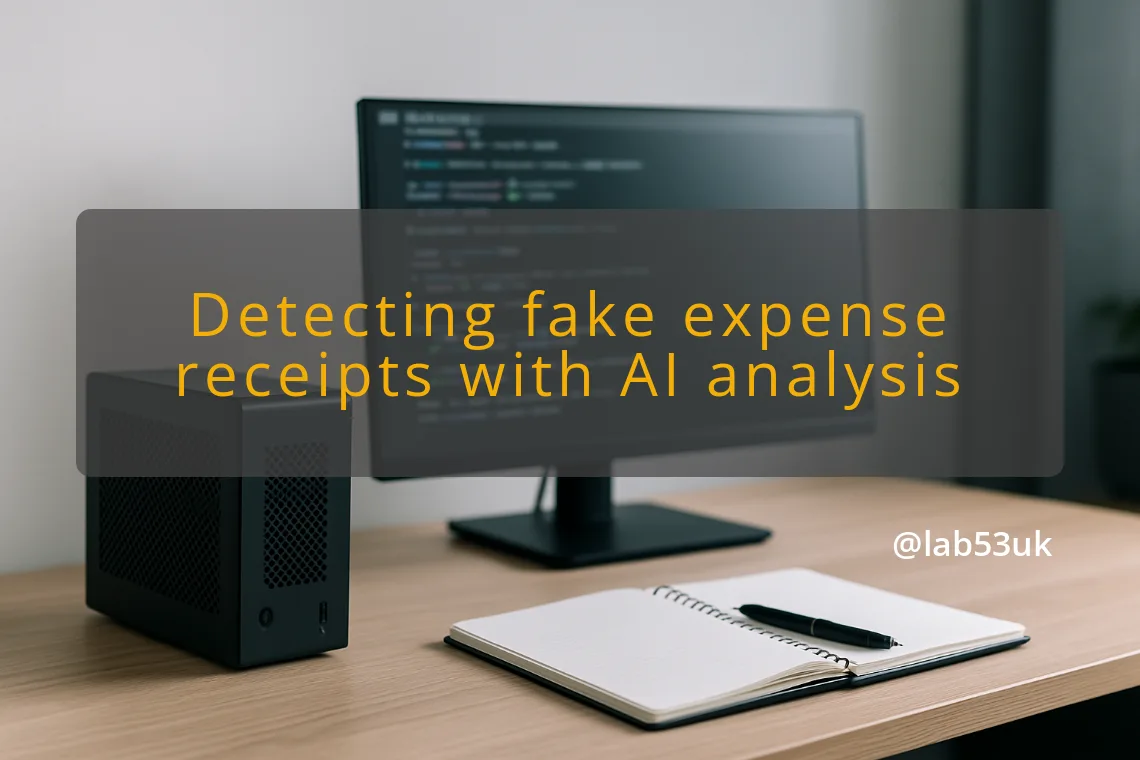Configuring AI Detection Systems to Combat Fake Expense Receipts
Fake expense receipts made with generative AI are easier to produce than ever. I focus on hard, technical controls that make fraud expensive and slow. This is about practical changes you can apply to your expense pipeline. I cover the detection options, the trade-offs, and the basic checks you should run automatically.
Introduction
Rise of AI-generated receipts
Generative models now produce photo-realistic receipts, logos and vendor details in seconds. That raises the risk of fake expense receipts bypassing simple manual checks. The fakes can mimic fonts, VAT numbers and layout. They even add believable totals and line items.
Challenges in detection
Image quality alone no longer separates real from fake. Attackers alter metadata, strip EXIF data, or re-save images to destroy tell-tale traces. Scammers also reuse genuine supplier templates. Manual inspection catches some cases, but it is slow and inconsistent. Automated systems that rely on surface cues will miss increasingly clever forgeries.
Importance of verification
Verification must be layered. I mean several independent signals, not a single classifier. Metadata analysis, invoice fraud detection rules, file integrity monitoring and bank-record matching all add value. Automate the low-risk checks, and escalate the ambiguous cases to trained staff.
Implementation Strategies
Metadata analysis techniques
Start with what the file gives you for free. Extract EXIF, timestamps, creation software and file hashes. Compare the image’s creation time to the expense date on the receipt. Look for obvious mismatches, such as a receipt dated 2025 with an image creation timestamp in 2018. Check the camera or software maker field. Many AI generators insert software identifiers or export tools. Treat empty or stripped metadata as suspicious, not definitive proof of fraud.
Do these checks:
- Capture file hash (SHA-256) at intake and store it with the claim.
- Record original filename and upload route.
- Extract EXIF and XMP fields for device and creation timestamps.
- Check PDF metadata for producer tools and font embedding.
Give metadata checks a score and flag mid-range scores for human review. Metadata can be deleted, so use it as one signal among many.
Integrating AI detection systems
Add an AI detection model that inspects image artefacts, text layout and micro-patterns. Use models trained on both genuine receipts and known fake samples. Train on local data where possible, because your vendors will have recurring invoice styles.
Operational notes:
- Run detection as a pre-approval gate. Reject only when multiple signals agree.
- Keep models versioned and logged. Record model ID, confidence, and input hash for audits.
- Combine detection scores with business rules. For example, a high-confidence fake on a high-value claim should block payment automatically.
Avoid black-box denial. If the model flags a claim, present the reasons to the reviewer: metadata mismatch, impossible font mix, inconsistent VAT calculation. That cuts time in review and reduces false positives.
Training staff on fraud recognition
Automated tools reduce load but trained humans catch context that models miss. Run short, hands-on exercises that show common fake patterns and model failure modes. Use examples from your own data.
Train staff to:
- Confirm vendor contact details and invoice numbers.
- Match supplier addresses to known records.
- Request proof of payment for unusual claims.
- Spot repetitive style artefacts across receipts.
Keep the training practical. Show screenshots of fake receipts, then show the exact checks that would have caught them.
File integrity monitoring practices
Treat receipts as files with integrity requirements. Record the ingestion hash immediately when a user uploads a receipt. If the same claim is re-uploaded later with a different hash, flag it.
Practical checks:
- Maintain an append-only log of uploads and edits.
- Alert on hash changes, filename rewrites or metadata edits post-ingest.
- Retain the original upload for 90 days at minimum, longer for high-value claims.
File integrity monitoring prevents attackers from swapping files after initial checks and gives a clear audit trail when disputes arise.
Automating expense controls
Automation reduces human error and enforces consistency. Build a decision tree that combines:
- Metadata score.
- AI detection confidence.
- File integrity status.
- Payment history with the vendor.
- Bank record match.
If a claim fails multiple checks, apply a stronger control: require original paper receipt, proof of bank transfer, or vendor confirmation email. For medium-risk claims, route to a reviewer with a standard checklist. Log every decision and the evidence used.
Concrete rule example:
- If AI confidence > 90% fake AND file hash mismatched on re-upload, block payment and request vendor invoice and payment proof.
- If AI confidence 60–90% OR metadata missing, route to reviewer with two verification steps: confirm vendor phone number and ask for bank statement matching the payment.
Keep the thresholds adjustable. Monitor false positive and false negative rates, and tune based on real outcomes.
Final takeaways
Make verification layered and measurable. Use metadata analysis, file integrity monitoring and invoice fraud detection together. Run AI detection models, but never as the sole arbiter. Train reviewers on concrete checks and keep an audit trail of hashes, model versions and reviewer decisions. That combination makes fake expense receipts harder to cash and easier to catch.








